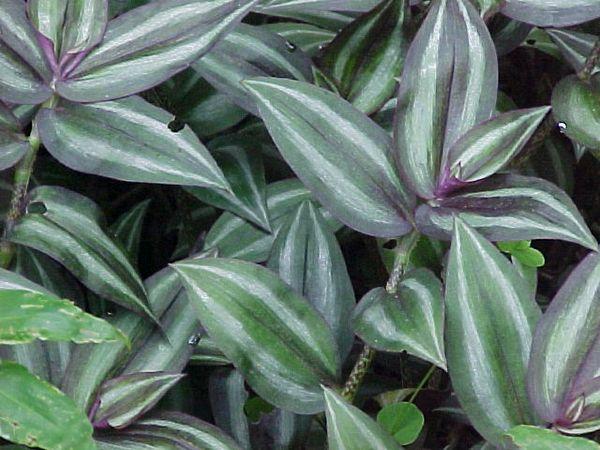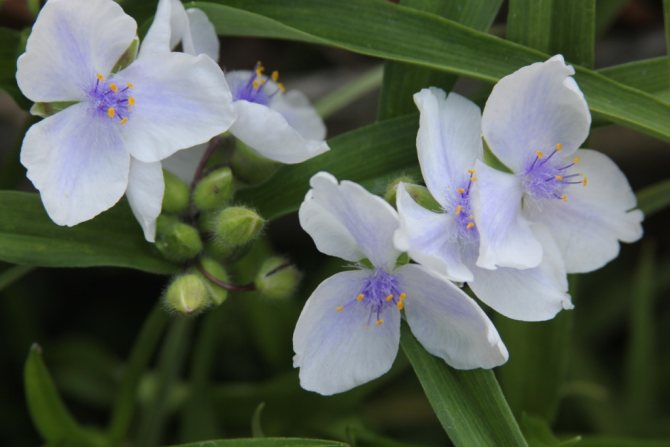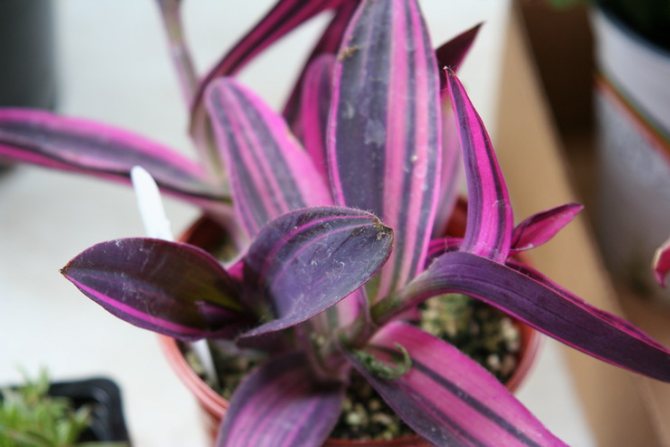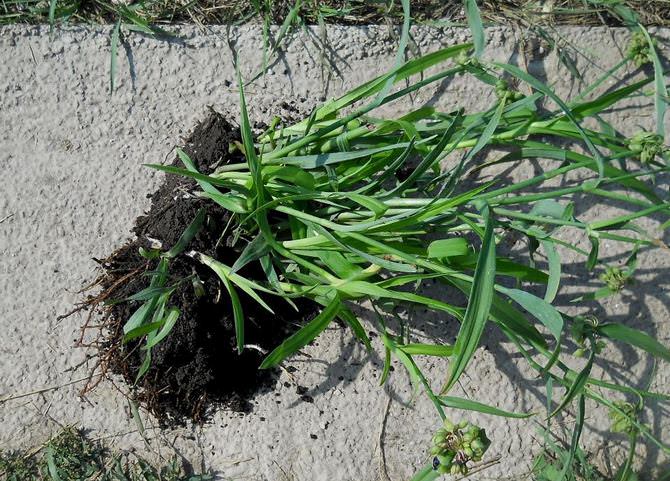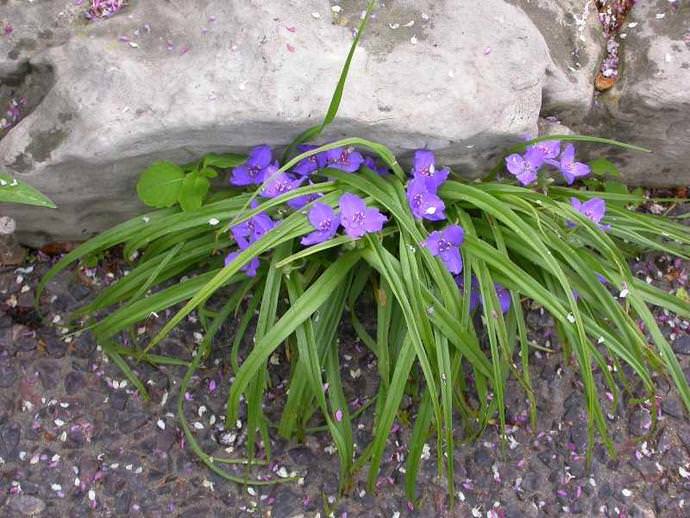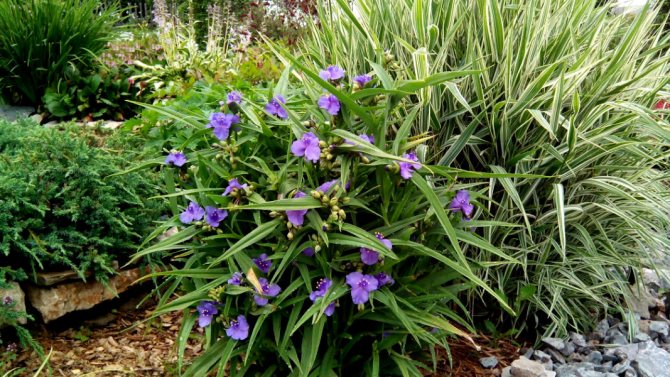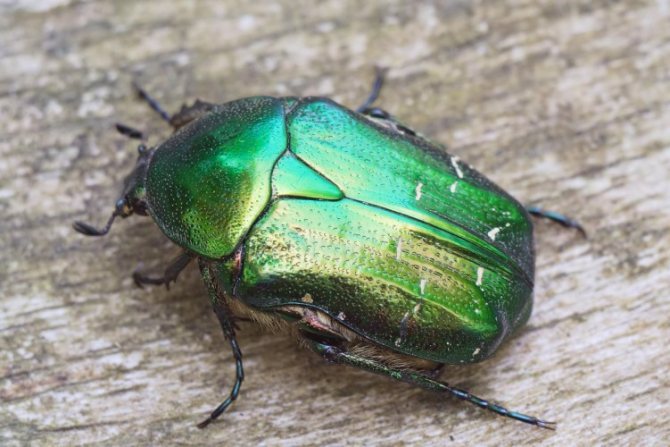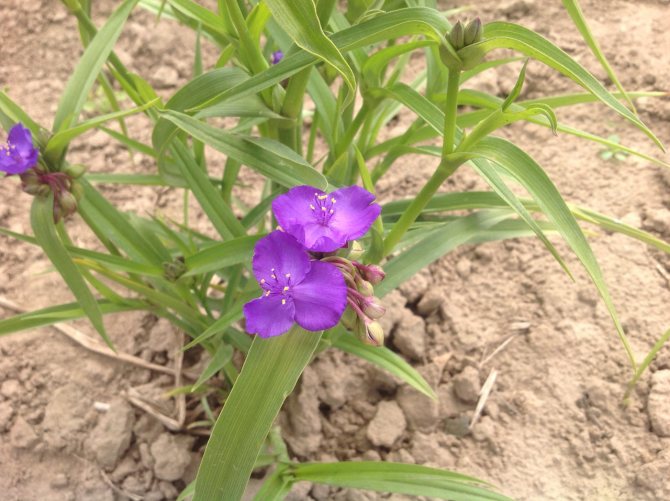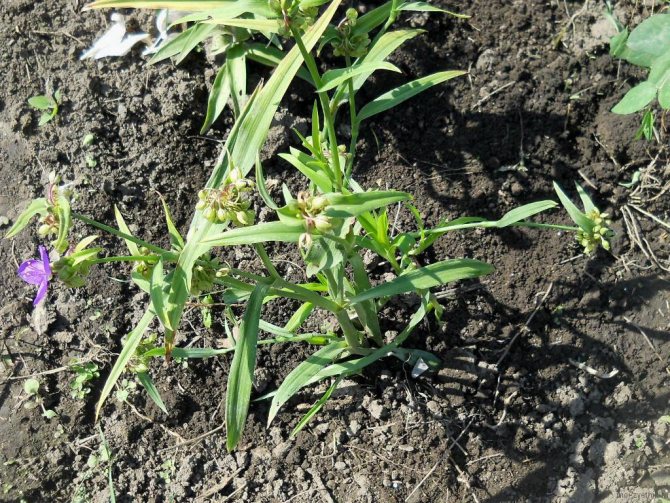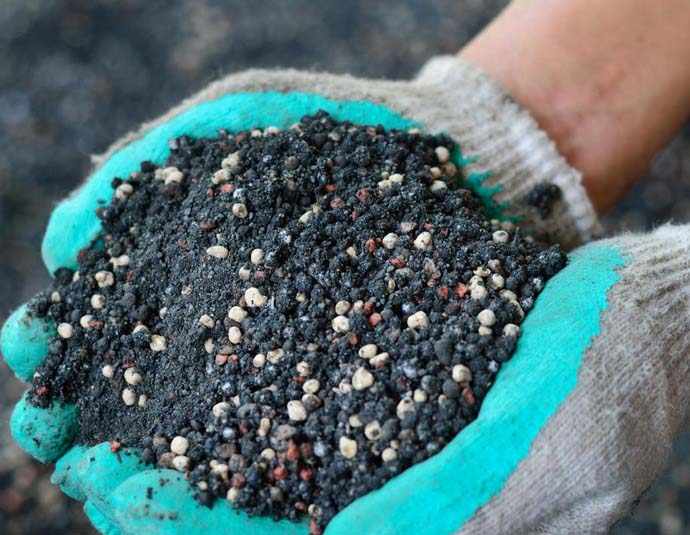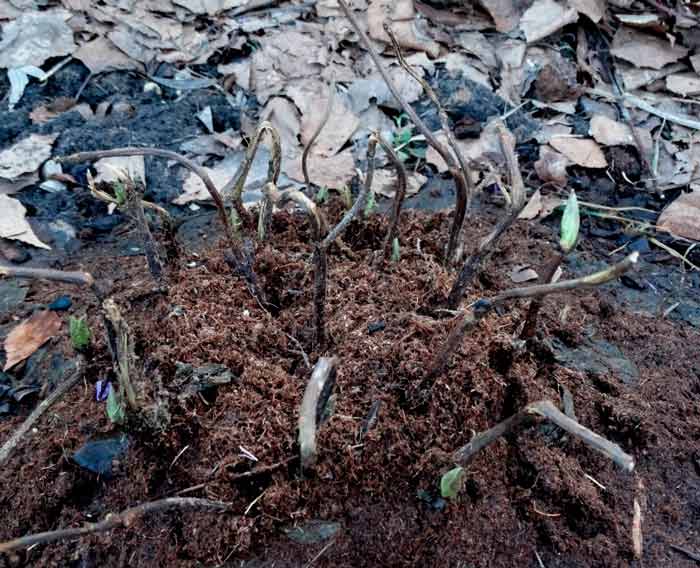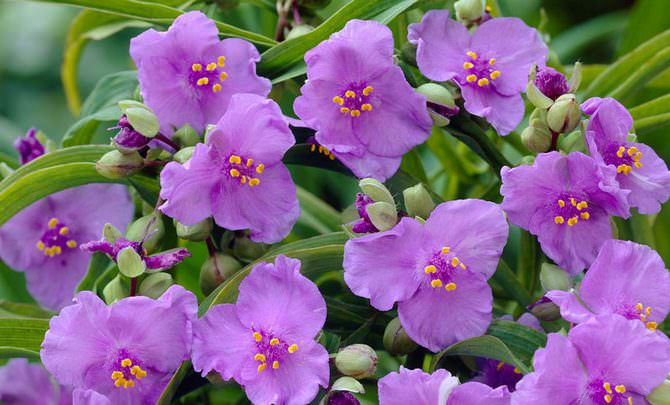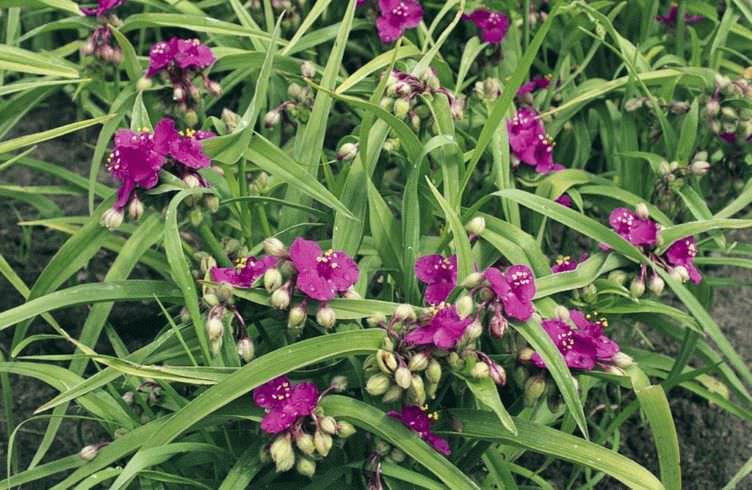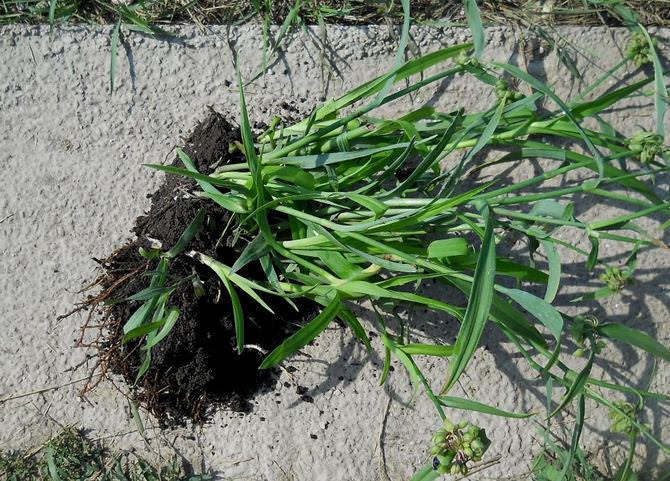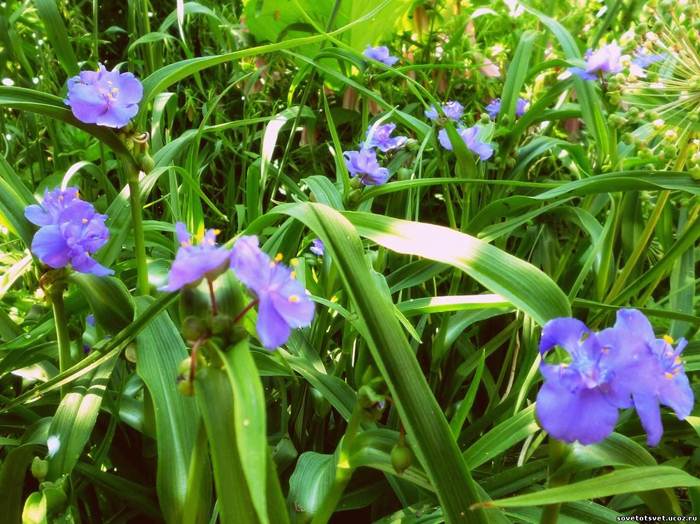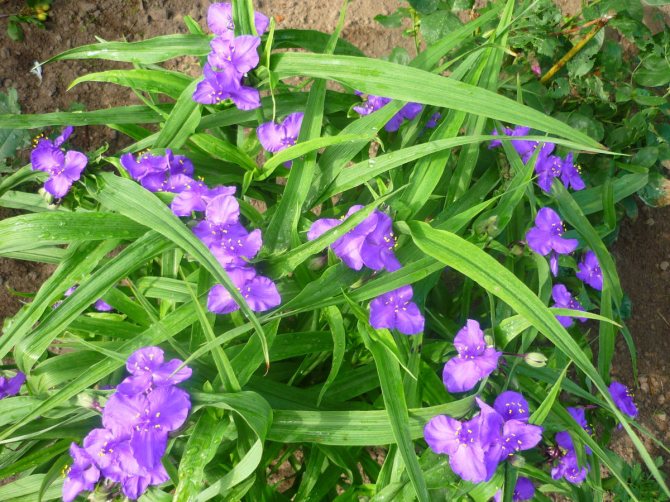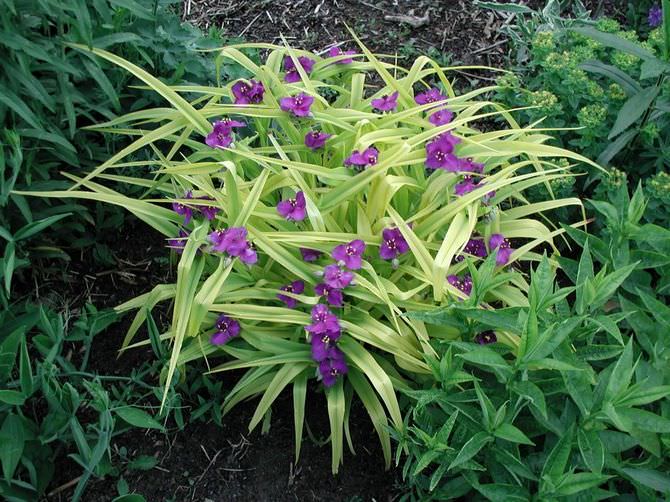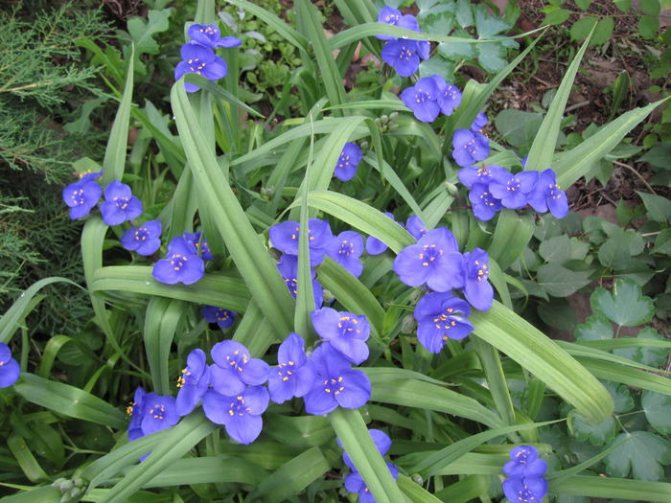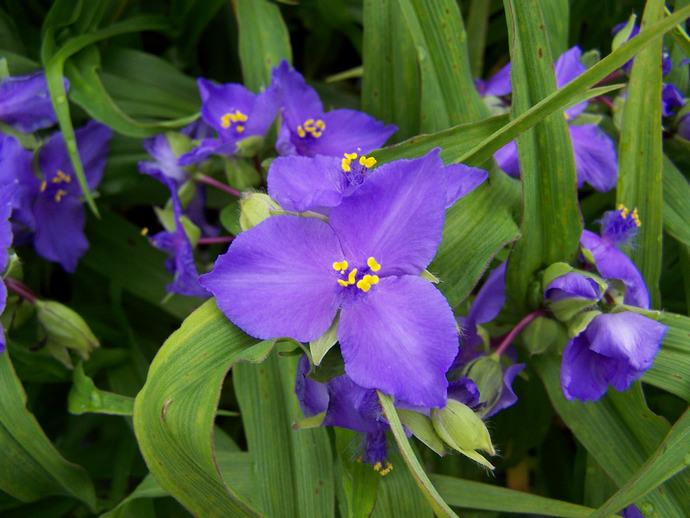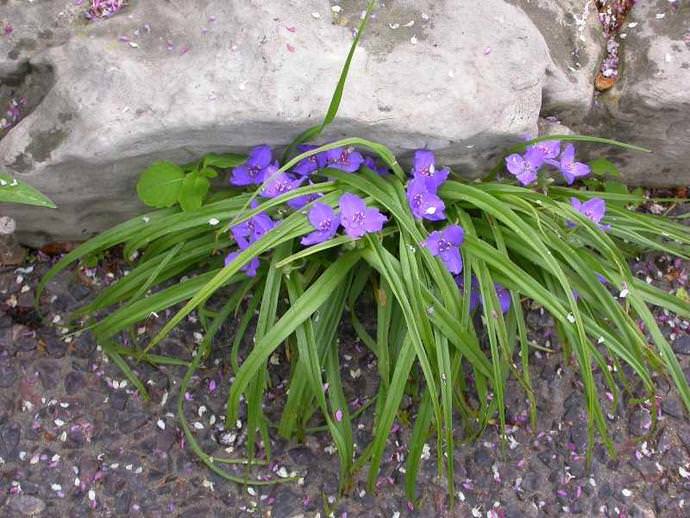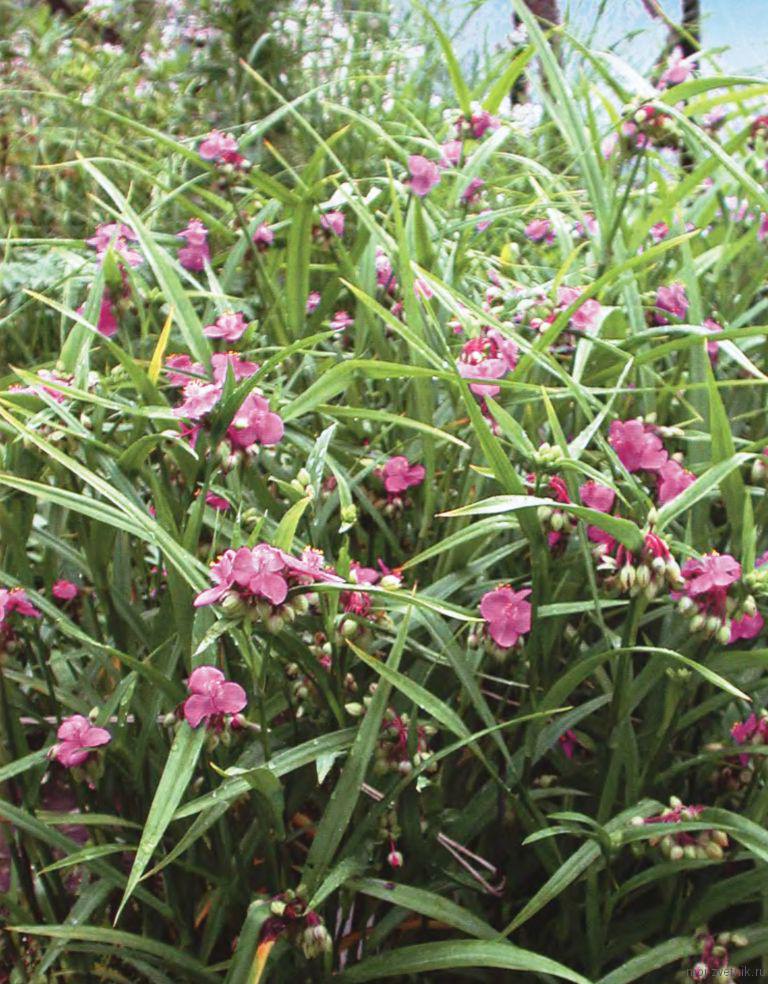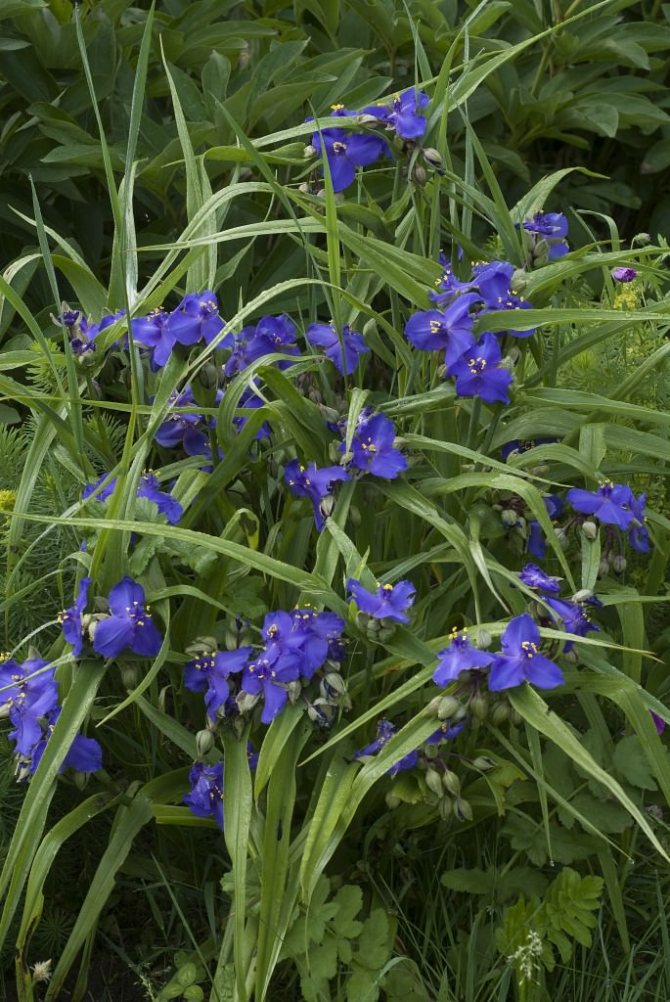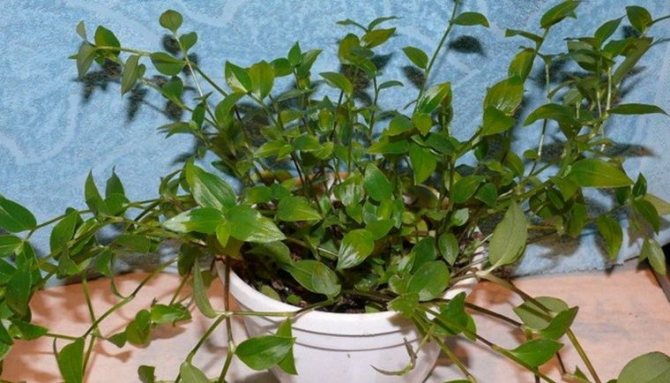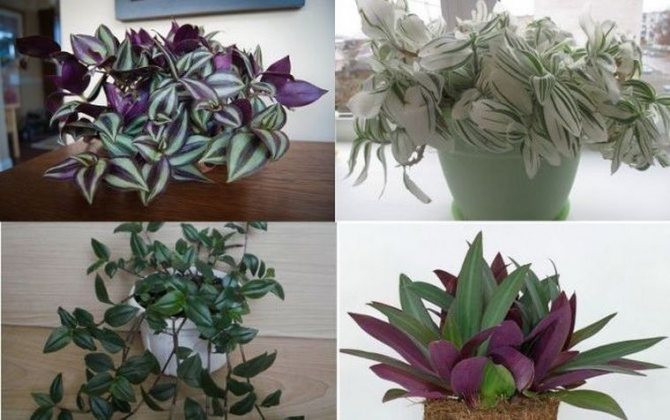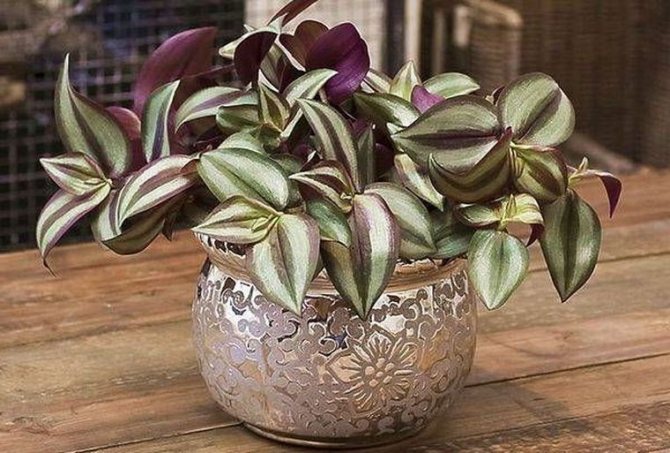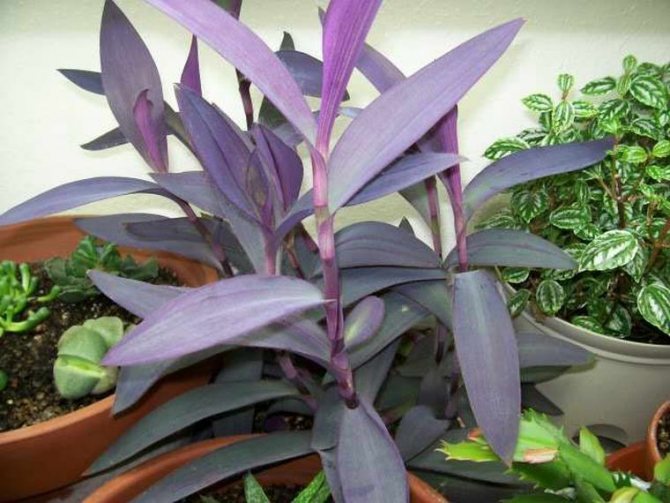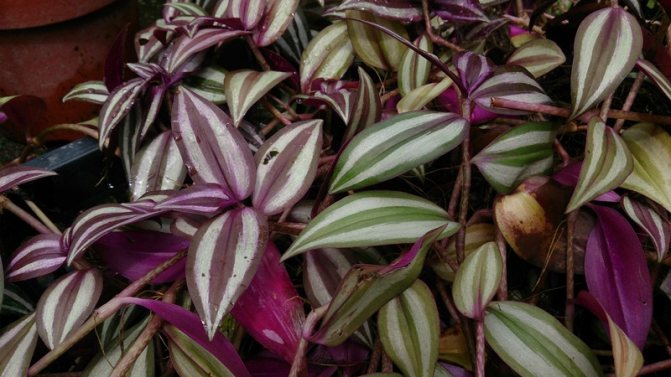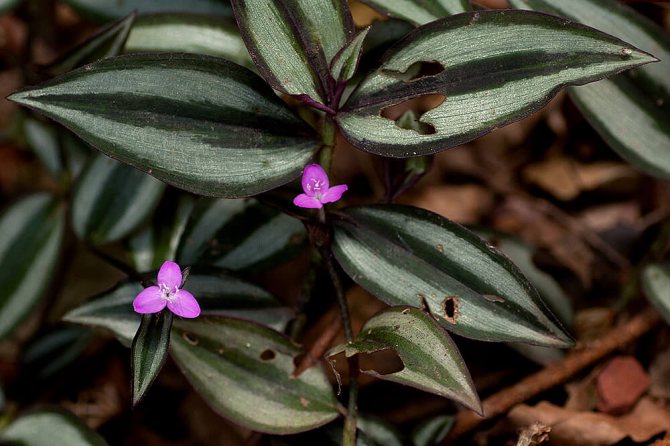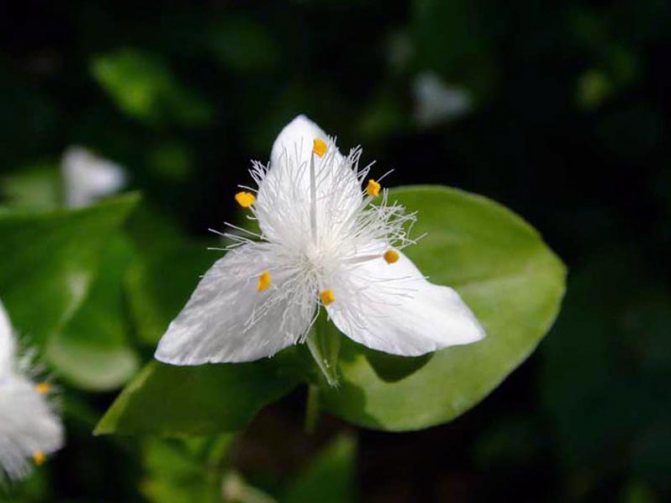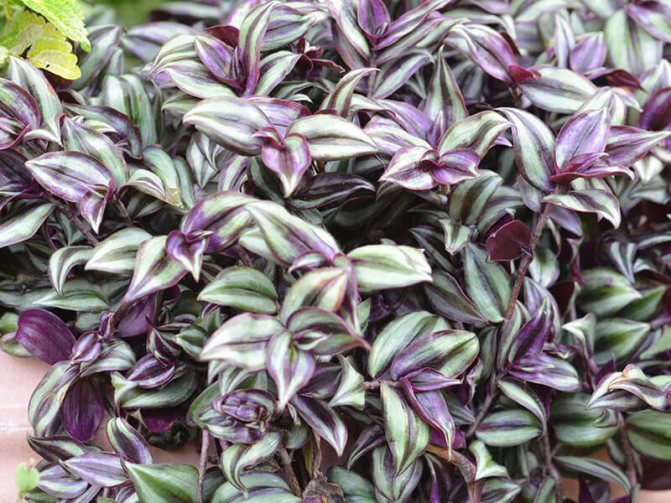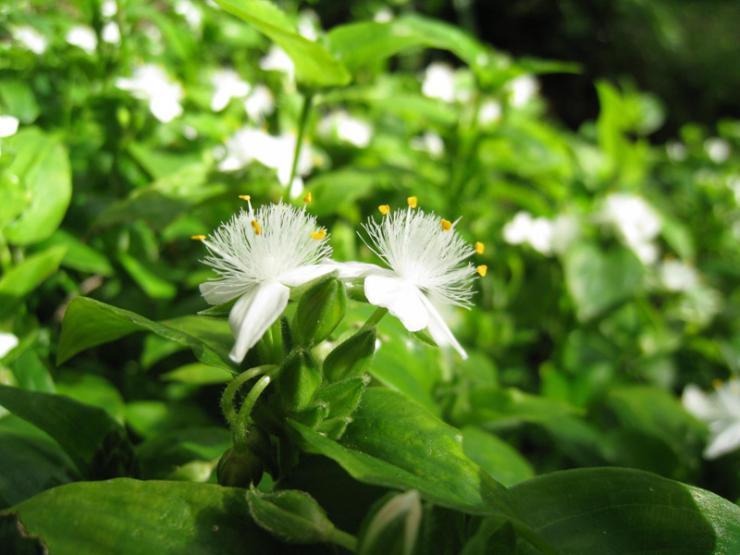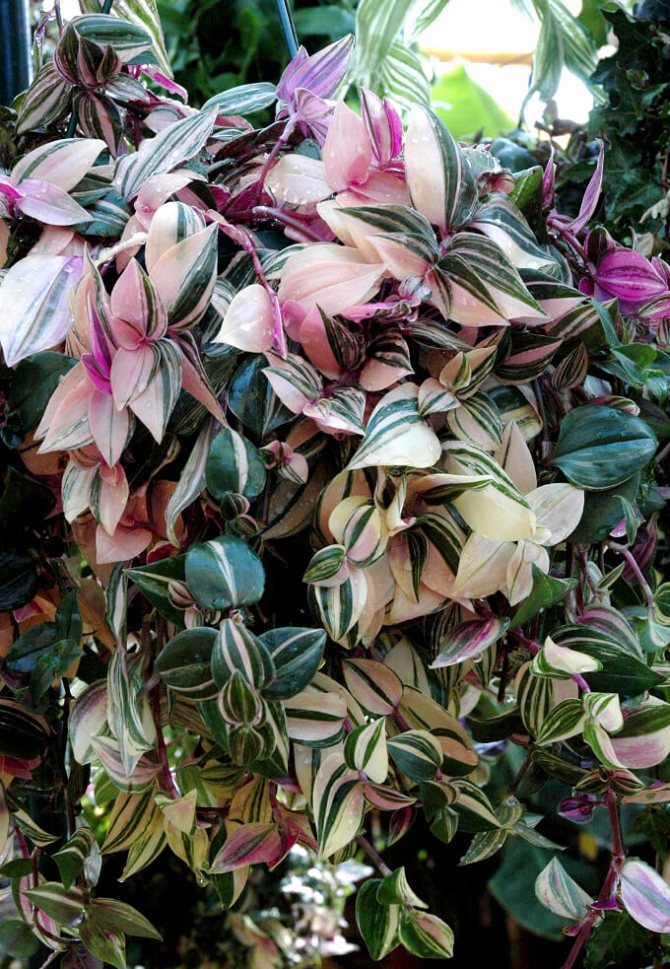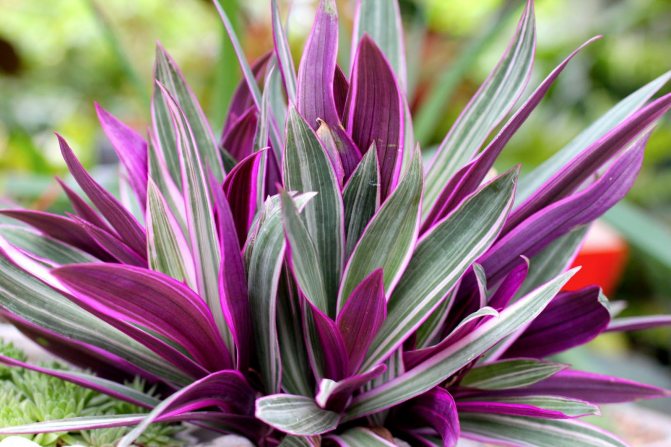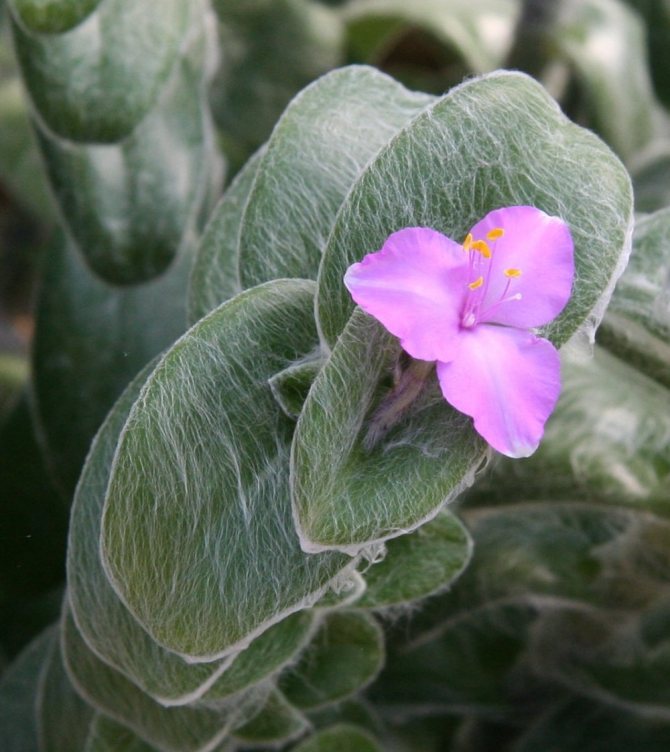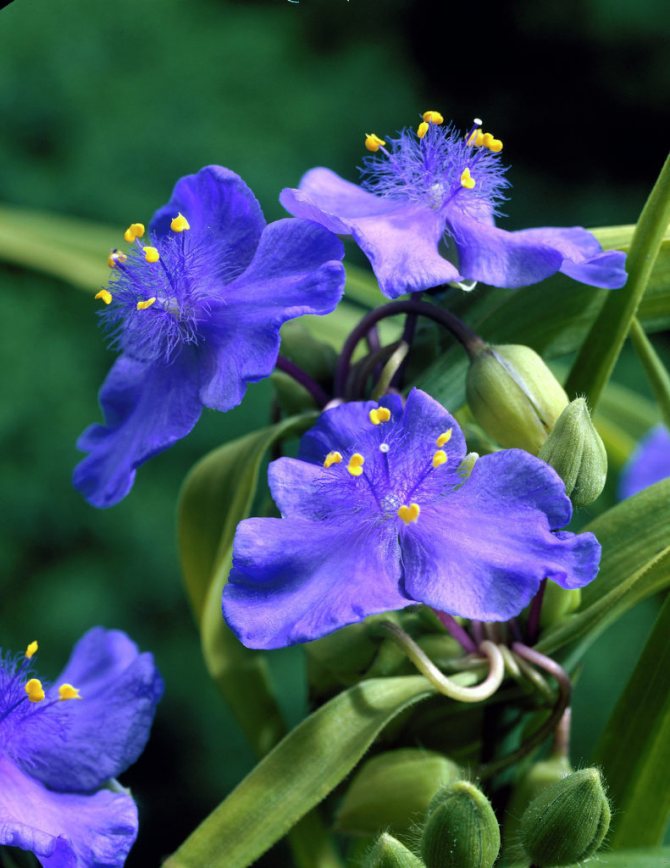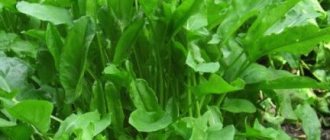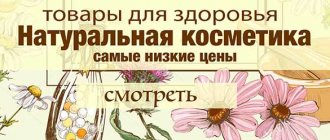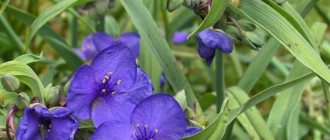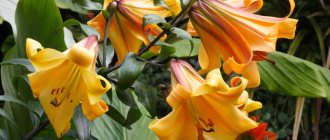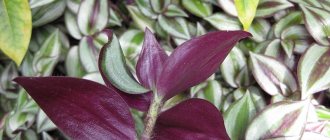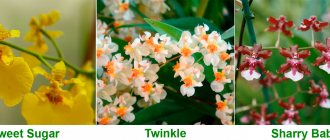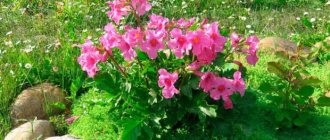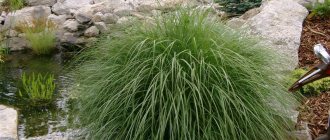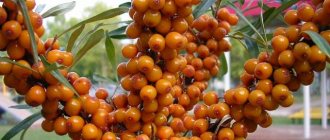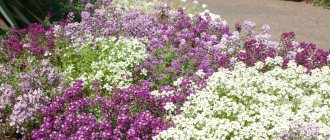Under the name Tradescantia (Latin Tradescantia) we know a whole family of Kommelinovs. Many of its representatives are successfully grown at home. The plants are named after the English gardener John Tradescant. And for the long hanging stems among the people, the room Tradescantia received the nickname "woman's gossip".
The plant has one unique property. Its flowers, usually blue in color, change color to bright pink when exposed to radiation. Therefore, it should be kept in their homes by those who live near nuclear power plants or nuclear test sites.
Watering
Watering is carried out with water at room temperature (having an average hardness) and settled for 2-3 days.
Water should be abundant on hot summer days.so that the soil in the pot does not dry out even from above. At the same time, make sure that the water in the pot does not stagnate.
In autumn, watering is gradually reduced and in winter it is watered much less frequently than in summer. The regularity of winter watering depends on the room temperature.
It is necessary that the topsoil dries up by 1-2 cm, and only after that the plant needs to be watered. In the spring, from the beginning of May, the watering of the plants is gradually increased.
Indoor tradescantia: home care
Indoor representatives of the Kommelinov family are unpretentious inhabitants of window sills. Caring for tradescantia at home does not put flower growers in front of insoluble questions.
Video on how to care for Tradescantia at home:
Location, lighting, soil
With enough sunlight, foliage takes on brighter, more saturated colors. Therefore, in a house for tradescantia, it is better to take well-lit corners. The lack of sunlight leads to the fact that the leaf plates turn pale, variegated varieties can lose stripes, acquire a monochromatic greenish color.
However, direct sunlight is also detrimental to a houseplant. Burns can occur on its leaves. The white-flowered tradescantia is the most resistant to heat and light.
Plants can be planted in ready-made specialized soil mixtures. But you can prepare the soil yourself: combine the deciduous soil with sod and humus in a ratio of 4: 2: 2 and add a little sand.
Temperature, humidity
The plant feels comfortable at any room temperature. The optimal value is from +24 to + 26 ° С. In winter, when the dormant period begins, the temperature can be lowered to + 12 ° C. The air humidity in the room where representatives of the Kommelinov family live is recommended to be maintained at 60%.
Watering
As an inhabitant of swamps in its natural habitat, Tradescantia loves frequent water treatments. Water it as often as possible during the summer months. The soil in the pot should not dry out. Winter watering is less abundant, they are carried out every 3-4 days. So that the roots do not rot in such conditions, the soil must be regularly loosened. A properly configured water treatment regime is the key to flowering.
How and what to feed
The optimal frequency of feeding is every two weeks. Any complex means available in the sale of specialized stores are used as fertilizers. You can also add a tablespoon of liquid fertilizer each time you water.
Features of winter care
In winter, a period of dormancy begins. The pot must be rearranged in partial shade, in a room with a cool temperature. Watering should be reduced. The plant is not afraid of cold and temperature changes, the main thing is to protect it from freezing.
How to transplant
Florists, as a rule, combine pruning and transplanting Tradescantia at home. Do this after wintering. The appearance of the plant during this period may not be very attractive: the stems dry out, the color changes.
Young members of the Kommelinov family need annual transplants. Old or bare shoots are cut, young ones are cut. The diameter of the planting tank should be approximately 20 cm. A shallow drainage is poured onto the bottom, then a layer of fresh soil. A plant is placed in it, the roots are carefully straightened. The soil is compacted and abundant watering is carried out.
Home care for indoor tradescantia on video:
Diseases
Tradescantia is resistant to various infectious and fungal diseases. Despite mistakes in caring for this plant, it usually does not get sick with anything.
Pests also rarely attack this flower. Most often it is affected by aphids.
Aphids reproduce in large numbers and, if the plant is taken out into the open air, the aphid can settle on its leaves and young shoots.
Insecticides are used to kill harmful insectsthat help completely eliminate pests.
Bloom
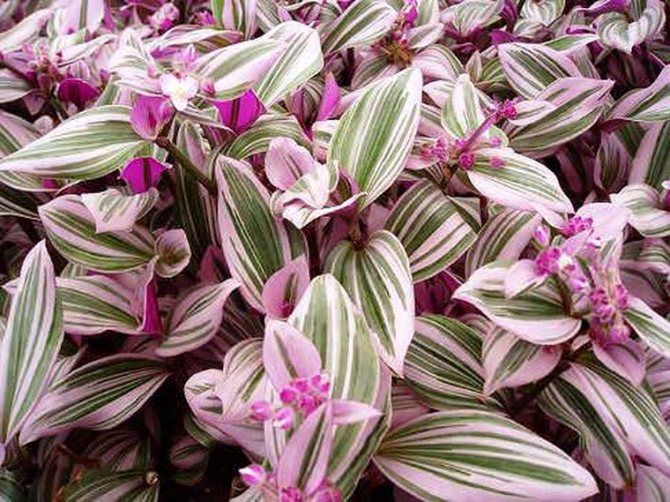
Home Tradescantia flowers can appear at any time of the year. The main condition is proper care, that is, sufficient illumination, correct watering and soil composition. The most abundant flowering in most varieties is observed in summer. Its duration is up to 3-4 months.
Problems
Tradescantia can suffer and lose its beautiful appearance due to lack of water, light and very dry air.
If the plant is poorly watered and the earthen lump is severely overdried, its leaves and stems become lethargic.
With prolonged drying of the soil, the leaves turn yellow and become stained. In this case, it is necessary to water the flower more often and more abundantly.
Tradescantia loses its variegation only when it is in a very shaded place. However, its colored leaves may turn green and growth may slow down.
Very dry air also has a negative effect on the plant.... Its leaves begin to dry out at the tips, and then fall off. To increase the humidity, it is necessary to spray the plant.
Varieties of room tradescantia: photos and names
There are many varieties of room tradescantia, among which there are the most attractive forms.
Setcreasia
Setcreasea purpurea is a type of perennial plant with lodging stems and violet-green, pubescent leaf plates up to 15 cm in size. Some varieties have pink stripes along the leaves. The flowers are small, pink.
Indoor flower purple tradescantia in the photo:


Zebrina
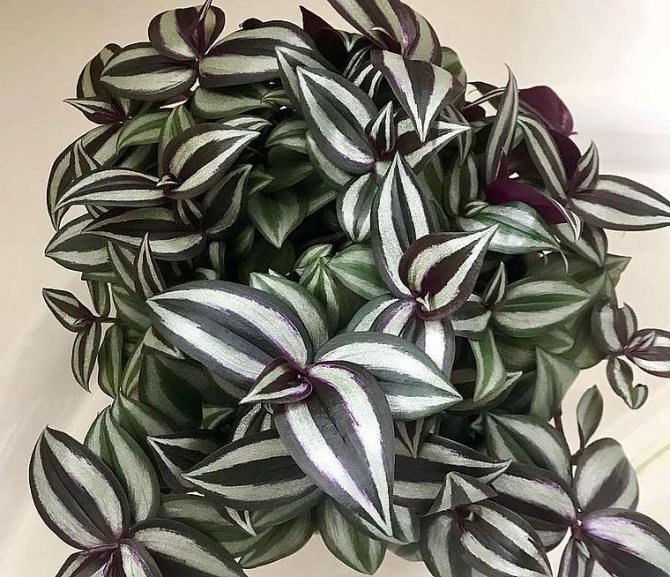

Tradescantia zebrina is a herbaceous, rapidly growing perennial. Its stems reach 1.5 m in length. Leaves are oval or spear-shaped, pointed, up to 10 cm in size.Coloring can be different, but all varieties have stripes, and their underside is often painted in purple shades. Flowers of white, pink, purple colors bloom in spring or summer.
Reo
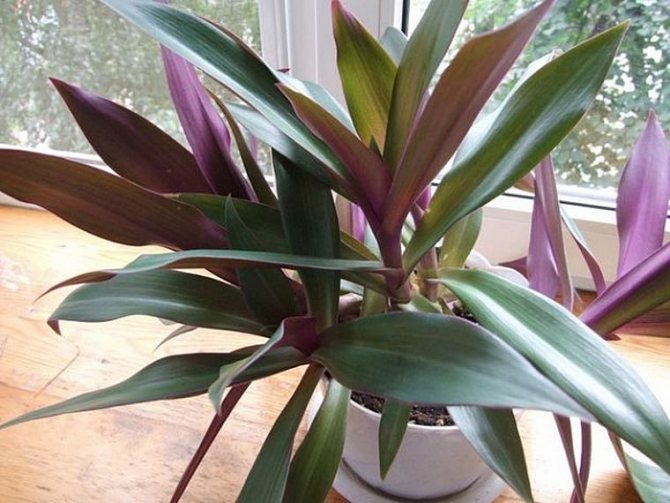

Tradescantia reo (Rhoeo) is an ornamental deciduous plant. Its hard leaf plates grow up to 30 cm. They are located on a sturdy trunk. Coloring - purple or reddish at the bottom, in the upper part it can be different, depending on the variety.
Riverside
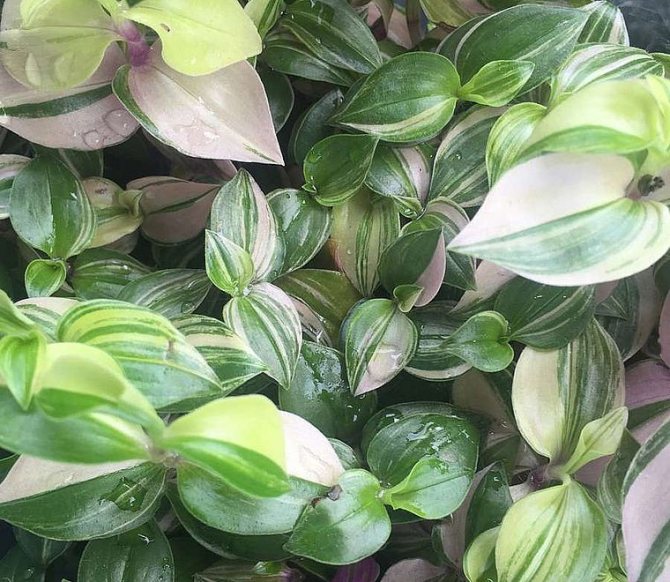

Riverine Tradescantia (Tradescantia fluminensis) - thin fragile stems rise above the soil, covered with purple-red skin.In more rare nodes, ovoid bright green leaves are formed about 2.5 cm long and 2 cm wide. The reverse side is purple-red.
White-flowered
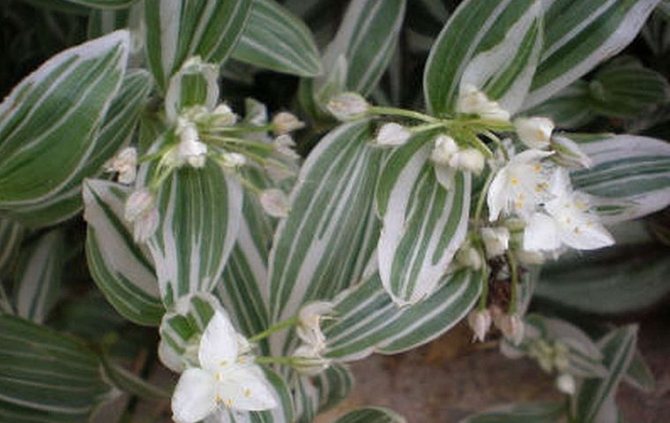

White-flowered tradescantia albiflora is one of the most popular species due to its light, brightly striped leaves and white medium-sized flowers. For successful cultivation, this species must be provided with good lighting, otherwise the leaf plates of white tradescantia can change color to green.
Small-leaved
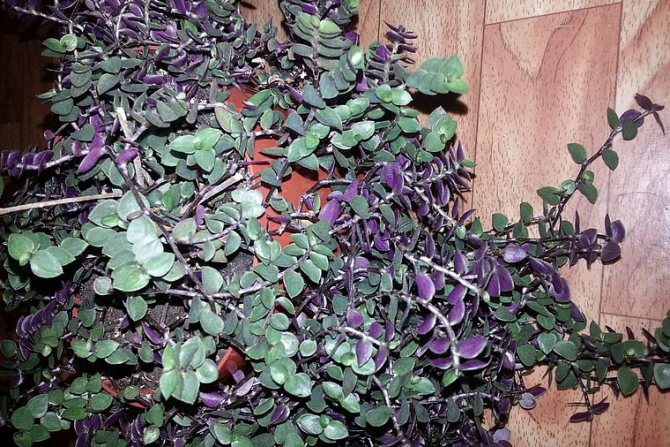

Small-leaved Tradescantia is a lush perennial with long hanging shoots. The foliage is medium-sized, fleshy, up to 5 mm in length, green, with a purple underside. Often planted in hanging baskets or used as a ground cover plant.
Tricolor
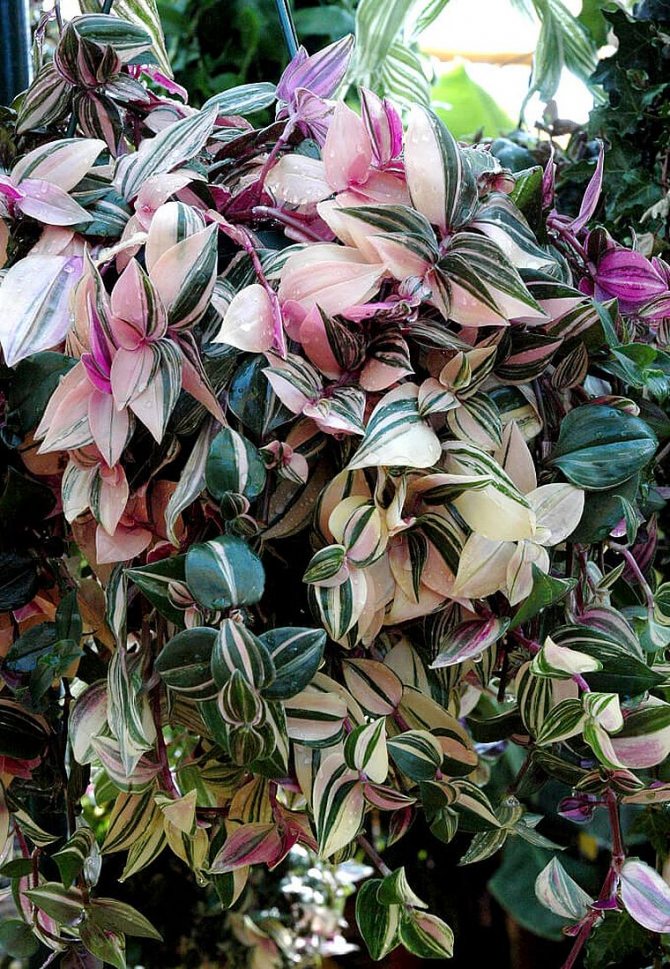

Tricolor - plants with a pale green color of leaves, along the central vein of which there are stripes of bright pink hue, and the sides are decorated with a silvery pattern.
Albovittata
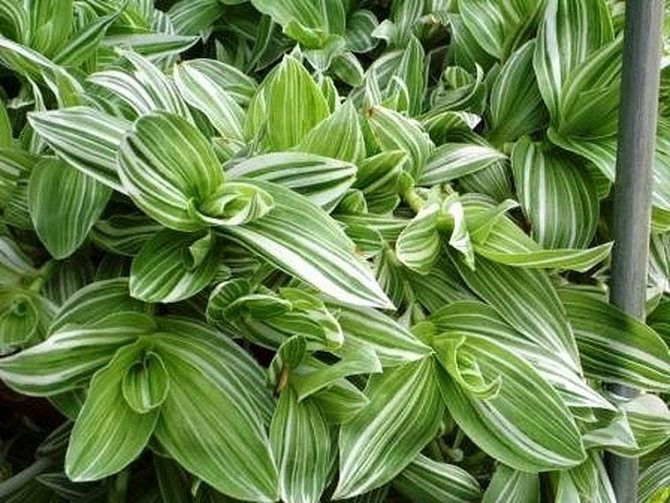

Albovittata is a variegated variety with pointed, glossy leaf blades. It is notable for the presence of thin stripes and snow-white flowers.
Reproduction
Propagate tradescantia by cuttings and seeds. Usually, vegetative propagation is used in room conditions. Seeds are sown to obtain varietal plants.
By cuttings, you can propagate at any other time.... Cuttings should not be short.
Usually 5 cuttings 15 cm in length are enough to grow one bush.
They are placed in water or immediately planted in one pot. Roots usually appear in 7-10 days.
Purchased varietal seeds are sown in the ground in March or April. From above, the container is covered with foil or glass. It is necessary to regularly moisten the soil and maintain a temperature of at least 20 ° C for the emergence of sprouts.
How to propagate
The best time for breeding is spring. During this period, the plants take root quickly. Such work cannot be carried out during the winter months.
Reproduction of room tradescantia is possible in several ways:
- Seeds... They are sown in a mixture of sand and peat soil, maintain a temperature of + 20 ° C, regularly watered and ventilated a container with seeds. After the development of the third leaf, the seedlings are transplanted into small containers. Flowering begins in the third year.
- Cuttings... Cut shoots are divided into cuttings 10-15 cm long. They are planted in a mixture of compost soil, sand and humus.
- By dividing the bush... The rhizome of Tradescantia is carefully dissected during transplantation, and the wounds are disinfected with crushed activated carbon. The bushes are placed in small pots.
Video on how to propagate a flower at home:
Transfer
Young bushes of Tradescantia are transplanted annually or once every 2 years. Usually there are up to 5 plants in one pot, so they need to be transplanted at the same time by transshipment. This method will allow less trauma to the root system.
The pot is chosen a little more than the previous one, since the plant has a not too developed root system.
Drainage is laid at the bottom of the pot at least 3 cm thick from expanded clay, pebbles or broken bricks.
The plant removed from the old pot is placed in a new one and fresh soil is added around the root system. After transplanting, the plant needs to be watered well.
Botanical description
The birthplace of Tradescantia is South America. The natural habitat is tropical and temperate zones from northern Argentina to southern Canada.
Plants have creeping stems or form basal rosettes. Their leaves are arranged on very short petioles. They are oblong, elliptical or lanceolate in shape. Foliage color - green or dark green, purple, white, burgundy. The underside often has a contrasting shade. The leaf blades of variegated varieties have stripes.
Tradescantia flowers are small, with three triangular petals. They are located on the tops of the shoots, can be solitary or form low-flowered inflorescences. Painted in white, lilac or pink shades.
In the photo, a room tradescantia:
Photo
Plant characteristic
These vines from the genus of perennials naturally live in the tropical forests of South, Central America and in some states of the United States.
In the climatic conditions of Europe, this plant is most often grown indoors or in greenhouses. However, modern breeders have grown many hybrids that grow quietly in the open field.
The special decorativeness of this plant is in the bright green foliage, which descends from the pots in an abundant cascade. The shape of the foliage can be varied - oblong, elliptical or oval.
Tradescantia: characteristics (video)
The foliage has characteristic veins. Shoots can intertwine, for this they are called "woman's gossip." Foliage can have a wide variety of colors and shades - from green to purple, purple, variegated, even yellowish. But only garden and home species of this plant please with flowering. Moreover their flowering is long - the entire summer season until September.
This flower moisturizes the environment well. Tradescantia removes bacteria and electromagnetic radiation from the air. Garden tradescantia, due to its beauty, look great in single plantings and will decorate any site. They also work well with anemones, geraniums and other perennial flowering plants when planted in flower beds.
Also read: Irises in autumn: care technology and winter preparation features
Composition Basics: The Right Neighborhood
The shape of the bush and its splendor is determined by the place of planting. In a dark, windy place, the shoots will lose stability, and the flowers will be dull. The optimal place for a shrub is a light openwork partial shade. Here the foliage of the plant will be richly green, and bright large flowers will delight the eye. Garden Tradescantia can be tied to an artificial support. Its alternative will be well-chosen neighbors, creating a natural support.
Anemones, astilbe, swimsuits, hosts, astrantia, brunners, marigolds, geychera, cuff, geranium, gravilata, lungwort, variegated sedge can be planted next to the bush. Plants will reliably support the garden Tradescantia, and with their flowers and refined shape of leaves, they will create a harmonious composition and emphasize the dignity of each other.
It is not recommended to plant next to a representative of the Kommelinovye family, which react poorly to excessive moisture in the soil and air.
The bush grows well near artificial reservoirs and streams. High humidity has a beneficial effect on the health of garden vegetation. She feels no less comfortable in various flower beds, rocky gardens, flower beds, naturalized garden corners.
Regardless of the type of plant, its flowers are odorless and are good honey plants. A large number of colorful butterflies enjoying the nectar of Tradescantia will be the highlight of the hacienda.
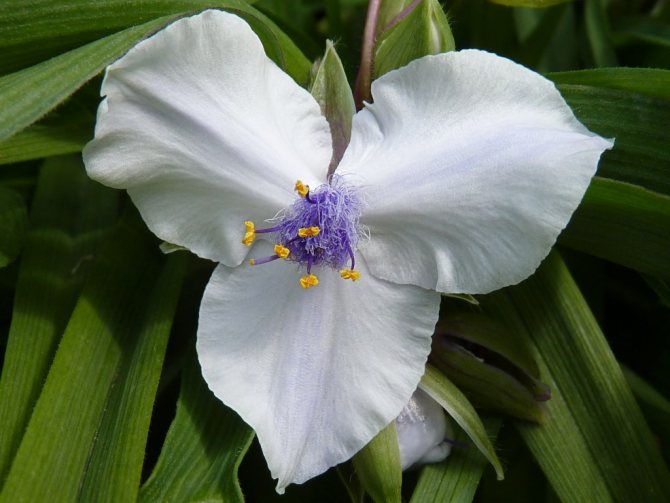

Fertilizer
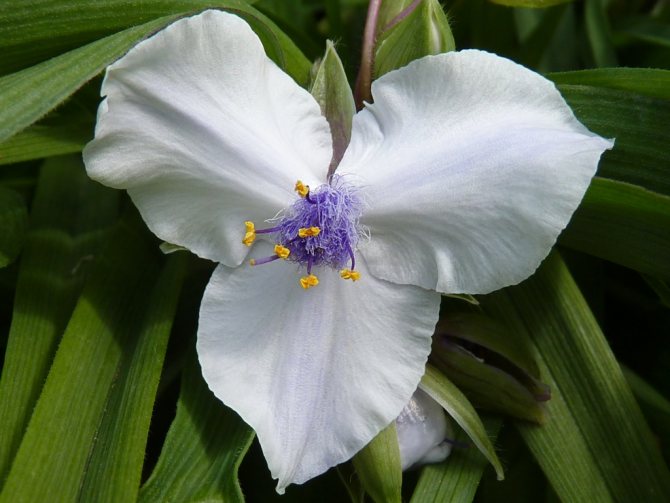

There is one more item that garden tradescantia needs. Planting and caring for it includes fertilizing the soil. The shrub prefers complex mixtures for this purpose. Those designed for flowering shrubs work well. Every year at the beginning of the spring period, you need to fertilize the soil. Once again, you need to repeat the procedure at the very beginning of budding. In winter, it is better to give the plant a rest and do not need to fertilize.
Purchase and adaptation
When choosing a flower in a store, you need to determine the degree of its freshness and health. The selection is carried out according to the following criteria:
- the aboveground part is fresh and juicy;
- leaves without holes, yellow, black and brown spots, and also without yellowness;
- stems and shoots do not contain cracks, breaks, uniform color.
After purchase, the Reo flower is quarantined for three weeks. During this time, you can determine if he has diseases and parasites. If they are found, it is necessary to carry out treatment with appropriate pesticides.
Garden views
There are several species that grow well in garden plots without any problems; in the fall, you only need to cut off the shoots and mulch.
Virginia ("widow's tears", "weeping lady")
Erect branchy shoots, flowering from July to August in small, gracefully curved flowers. Each bloom lasts only one day, then the petals roll up, turning into a mass resembling a thick gel, from which a seed capsule is formed. Varieties:
- "Atrorubra" - deep red flowers;
- "Coerulea" - blue flowers;
- "Rosea" - pale pink flowers;
- "Rubra" - bright red flowers.
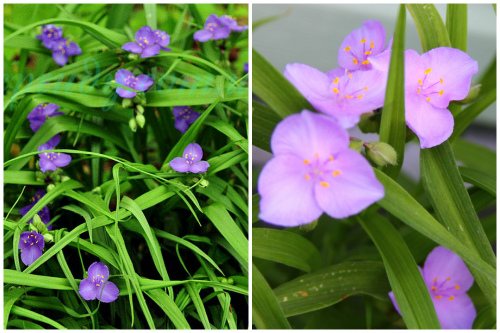

Anderson
The species is very similar to the Virginia Tradescantia, but the leaves are grassy and narrow, the flowers are larger, there are terry varieties. Varieties by color of petals:
- white - "BS-Eva", "Innocence" (with wavy petals), "Iris Pritchard" (with purple (with a pale lavender center);
- blue - "Angel Eyes", "Caerulea Plena" (terry);
- lilac - "Fairy";
- purple - "Blue and Gold" (with reddish-yellow foliage);
- pink - "Bilberry Ice", "Pink Chables";
- red - "Karin", "Concord Grape";
- blue - "Leonora".
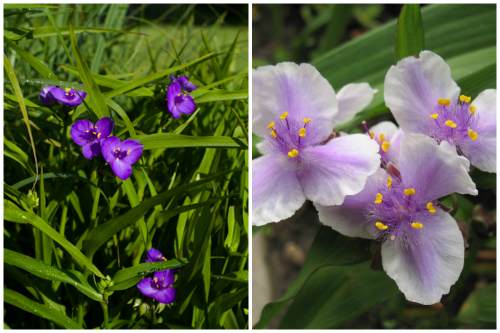

Blossfeld
This species has narrow, oblong leaves, green on the upper side with yellowish-red strokes, purple on the bottom. The flowers are pink with a lilac tint.
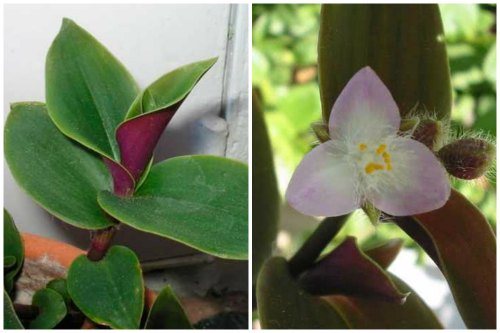

Basic planting and grooming requirements
All hybrids of garden tradescantia are adapted for planting in open ground, they are unpretentious and undemanding. However, you should not plant these creeping shoots in the open sun. Shaded areas are best suited for planting. It is here that the beautiful lush bushes of Tradescantia grow. Watering should be regular, but not plentiful, otherwise the plants will water. Under the open rays of the sun, the flowers quickly wither and fall off.
And only the variegated species of this plant thrive in the open sun. But in the shade, they lose the brightness of the color of the foliage, fade and fade. The most suitable temperature regime for tradescantia is from 13 ° C to 24 ° C.
In the hot season, the plants are watered more often, but there should be no stagnation of water in the ground. During cooler seasons, the amount of watering is reduced. Tradescantia can withstand drought for a long time, but this adversely affects the flowering and brightness of the foliage color.
Also read: How to properly prepare clematis for winter
In one place, this perennial plant feels good for several years, without needing a transplant.... Therefore, the beds for these flowers are prepared in advance, saturating them with organic fertilizers (manure, humus or compost).
Features of care - lighting and temperature conditions
In conditions of home cultivation, Tradescantia prefers bright diffused light, the amount of direct sunlight, especially in the summer, is better to limit, but variegated varieties are more photophilous.
Normal room temperature from 18 to 22 ˚С is quite acceptable. In the cold season, it is better to keep the plant away from batteries and ensure the minimum temperature, but not lower than 12 ° C. It should be said that Zebrina can tolerate even a short-term temperature drop to 0˚С.
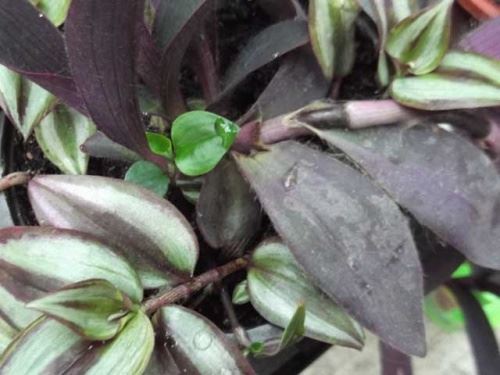

Neighborhood with other colors
Tradescantia very quickly loses its shape as a bush, especially after watering. Therefore, the plants are planted quite tightly to avoid tying everyone up. Unfortunately, this rule does not work for tall plants. This feature should be taken into account when choosing the type of tradescantia. To prevent the perennial from pulling out, experienced summer residents recommend planting a swimsuit, hosta next to it.Low-growing varieties are planted in close proximity to geraniums and lungwort. This neighborhood brings double benefits: geraniums or lungwort support Tradescantia and create beautiful harmonious compositions on the sites.
Bright Tradescantia Zebra
Zebra Tradescantia will not leave anyone indifferent. Large pointed foliage attracts attention with unusual colors. Green leaves have 2 large longitudinal silvery stripes. Between them there is a wide vein of a dark green hue. The same strip outlines the leaf along the contour. The underside of the leaves is blue-violet. Young foliage is decorated with purple-burgundy touches. They are scattered at the base of the leaf and around its edges.
The shoots of the plant have a reddish tint. They grow rapidly, reaching 40 cm in length. A year after planting, a large silvery-green foliage cap with a purple tint is formed.
During flowering, the plant is covered with magnificent scarlet three-petal flowers. Zebra tradescantia will adorn any interior.
The most famous variety of Zebra Tradescantia is Purpusii. The foliage of the plant of this variety is colored purple-lilac on both sides. To enjoy the decorative qualities of the variety in winter, the plant must be provided with additional lighting.
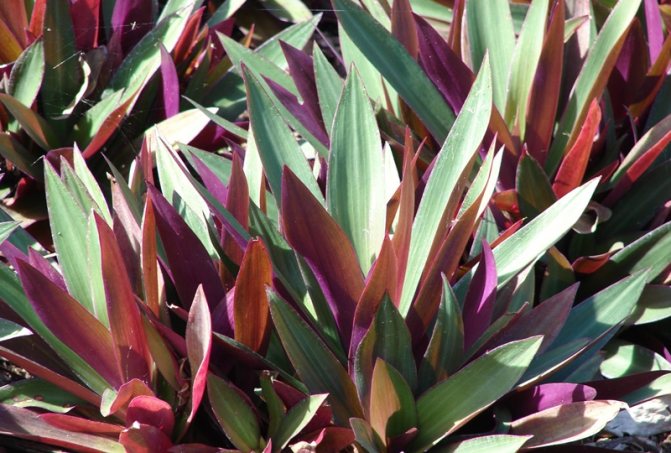

Application of tradescantia garden in landscape design
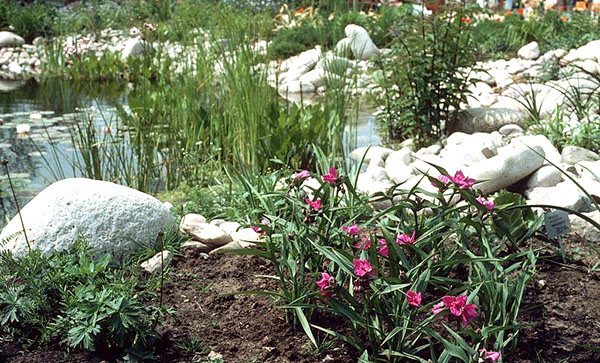

Garden tradescantia is widely used by landscape designers to create flower beds, flower arrangements, and decorate the coastal zone of water bodies.
Tradescantia is most successfully combined with ferns, irises, daylilies, geraniums, hosts, astilbe and geyher.
Considering the need for shading in the middle of the day, it is planted in the low parts of the alpine hills, near fences, in the shade of buildings.
When planting Tradescantia garden, they take into account the possibility of lodging, especially in tall varieties, and try to plant nearby plants that will serve as a good support for it.
Climbing plants - not only decorative
Few know how useful Tradescantia is as a houseplant. Purification and humidification of air, neutralization of electromagnetic radiation are only a small part of her "duties". It is highly desirable to grow Tradescantia for people with vision problems - it regulates eye strain.
And in a house where animals are kept, Tradescantia is simply necessary: its leaves are an excellent additional food for cats, hamsters, guinea pigs, turtles, parrots, as they contain many nutrients and vitamins. If you put the Tradescantia near the aquarium, and put a couple of lashes into the water, the fish will be happy to "pinch" its greens. Tradescantia is growing rapidly, and winter does not hinder its development, which means that you can provide your pets with year-round green complementary foods.
Care
It is with tradescantia that it is recommended to start your work in the garden. The plant needs additional care, although it is an undemanding crop.
Watering
Regular watering is the first requirement of the plant. Garden Tradescantia does not tolerate drought.
Top dressing
Top dressing is optional, but during the growing season and budding it is better to feed the flower by applying complex fertilizers based on minerals and organics.
Bloom
At the end of the flowering period, it is recommended to remove the peduncles in a timely manner so that seedlings do not get into the soil, which can germinate the next year and thicken the shrub chaotically.
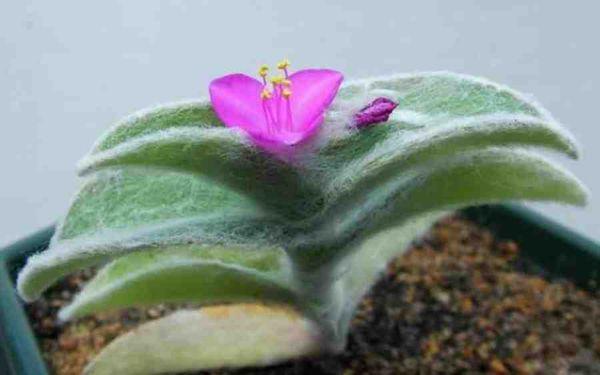

Wintering
For the winter, it is necessary to cut off the ground part of the plant and mulch the soil with peat or humus. Otherwise, Tradescantia may not survive the winter.
Pruning
Long, bare stems will develop as they grow and require pruning. It should be carried out in the spring.The resulting cut can be used as a cutting.
Diseases and pests
A very pleasant factor is that pests in this case do not touch such a plant. But still, there are cases when, for example, a spider mite infects a plant. In order to eliminate it, the reticulum will need to be treated with additional medication.
The plant is practically not affected by diseases. But if it is not properly looked after, then the roots may dry out, or vice versa - rot. In these cases, we are talking about improper watering, about its excess or lack.
Beneficial features
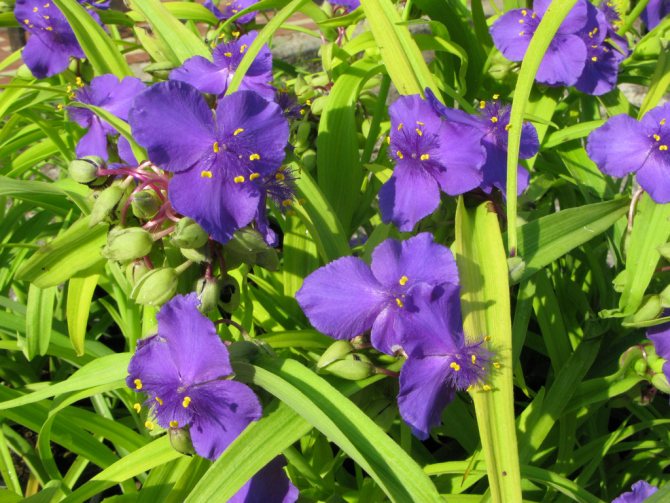

Garden Tradescantia has very useful properties that make it even more attractive for gardeners. It helps in the treatment of colds, pneumonia, bronchitis, gastrointestinal disorders. Also, the shrub perfectly disinfects the air. There are many recipes using this plant that are used in traditional medicine. Here is some of them:
- Problems with a runny nose. Prepare a decoction of two tablespoons of bush leaves and a liter of water. Boil the leaves and let stand for about half an hour. After straining, gargle three to four times daily.
- For the treatment of periodontal disease, it is enough to chew the leaves for ten minutes each time before eating.
- With furunculosis, you need to make a gruel from fresh leaves of a bush, and place it on the affected area overnight, wrapping it with a bandage.
This is not the whole list of Tradescantia's possibilities that will help you in the treatment of various diseases. Take good care of it, and you will grow in your garden both beauty and medicine.
Care errors
Possible mistakes that beginner gardeners make include:
- overfeeding the plant with nitrogen-based fertilizers;
- nearby heating devices;
- direct sunlight or, conversely, the localization of the plant in the shade;
- stagnant water.
Errors are accompanied by withering or decay of Tradescantia, its immediate death.
